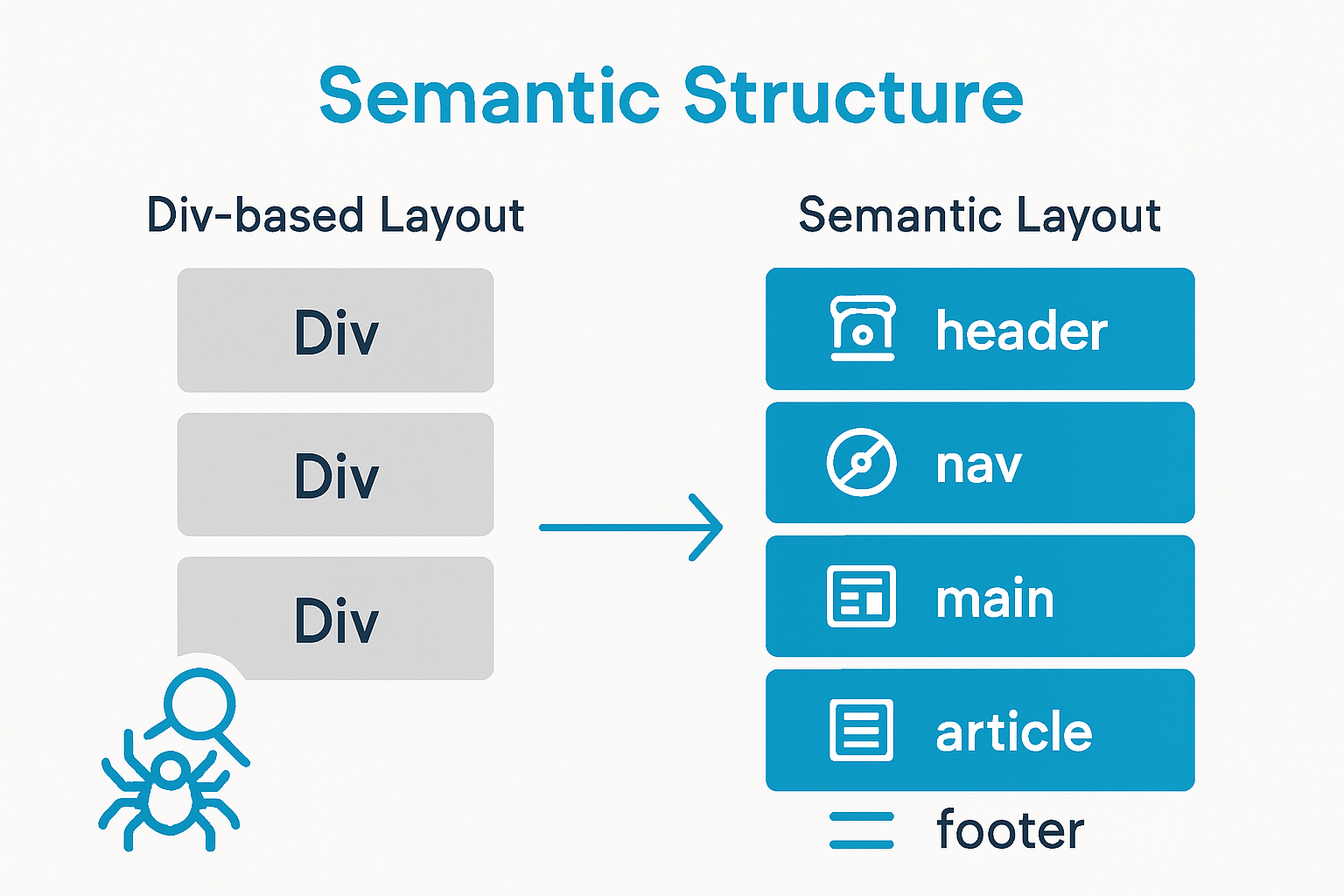Semantic HTML is changing how websites talk to search engines. Sites using key semantic tags can see better rankings and make content easier to find, especially for users relying on assistive technology. Surprised? Many still cling to plain divs and ignore the power these elements bring. But what most people miss is this. Semantic HTML does not just help robots. It actually makes your website smoother and more readable for everyone.
Table of Contents
- What Is Semantic Html And Its Role In Seo?
- Why Semantic Html Matters For Search Engines
- How Semantic Html Enhances User Experience
- Key Semantic Elements For Effective Seo
- Real-World Applications Of Semantic Html In Seo
Quick Summary
| Takeaway | Explanation |
|---|---|
| Use semantic elements for SEO | Implementing semantic HTML improves search engine understanding of content relevance and structure. |
| Enhance accessibility with semantic HTML | Semantic elements provide better experiences for users with assistive technologies, aiding navigation and comprehension. |
| Aid search engines with clear structure | Use semantic HTML to establish content hierarchy, helping crawlers quickly identify important information on your webpages. |
| Optimize content for featured snippets | Proper semantic markup increases the chances of appearing in featured snippets, enhancing visibility in search results. |
| Combine SEO with user experience | Semantic HTML improves both search engine visibility and user interactions, creating a better overall web experience. |
What is Semantic HTML and Its Role in SEO?
Semantic HTML represents a powerful approach to structuring web content that goes far beyond traditional HTML markup. At its core, semantic HTML provides meaning and context to web page elements, enabling both browsers and search engines to understand content more intelligently.
Understanding Semantic Structure
In semantic HTML, elements are chosen based on their intrinsic meaning rather than their visual presentation. Unlike generic “
” tags, semantic elements like <header>, <nav>, <article>, and <footer> communicate the specific purpose and relationship of content. According to Stanford University’s Office of Digital Accessibility, these structured elements help visitors using assistive technology and improve web page SEO rankings by helping search engine bots comprehend page content more effectively.
Key Benefits for Search Engine Optimization
Semantic HTML provides multiple advantages for SEO performance:
- Improved content understanding by search engine crawlers
- Enhanced webpage structure and hierarchical information
- Better accessibility for users with screen readers and assistive technologies
Search engines like Google increasingly prioritize websites with clear, meaningful content structures. By implementing semantic HTML, websites signal their content’s relevance and organization more precisely. This clarity helps search algorithms better match content with user search intent.
For advanced SEO insights, explore our guide on semantic search strategies.
Why Semantic HTML Matters for Search Engines
Search engines continuously evolve to interpret web content more intelligently, making semantic HTML crucial for modern digital visibility. By providing clear, structured context about webpage content, semantic HTML helps search algorithms understand and rank web pages more accurately.
Content Comprehension and Ranking Signals
Search engines like Google employ sophisticated algorithms that analyze webpage structure beyond simple keyword matching. Semantic HTML serves as a critical communication tool, offering explicit signals about content hierarchy, relationships, and meaning. Proper semantic markup allows search engine crawlers to quickly discern the most important information on a page, determining relevance and potential ranking positions more effectively.
According to California State University’s research on web search engine development, incorporating semantic knowledge significantly enhances search result precision by providing deeper contextual understanding.
Critical SEO Performance Advantages
Semantic HTML delivers multiple strategic advantages for search engine optimization:
- Enhanced content indexing and interpretation
- Improved website structure clarity
- More accurate content categorization
- Higher potential for featured snippet selection
By implementing semantic elements strategically, websites can communicate their content’s purpose and significance more transparently. This approach helps search engines understand not just what content exists, but why it matters to users.
Learn more about advanced semantic search strategies to elevate your website’s search performance and visibility.
How Semantic HTML Enhances User Experience
Semantic HTML transforms web interactions by creating more intuitive, accessible, and meaningful digital experiences. Beyond visual presentation, semantic markup provides a deeper layer of understanding that directly improves how users navigate and interact with web content.
Improving Digital Accessibility
Websites built with semantic HTML become significantly more accessible across different devices and assistive technologies. Screen readers and other adaptive technologies rely on semantic elements to interpret and communicate web content accurately. According to WebAIM from Utah State University, semantic HTML enables more comprehensive content interpretation, allowing users with disabilities to navigate websites more effectively.
Critical User Experience Benefits
Semantic HTML delivers multiple advantages for improving user interactions:
- Enhanced navigation and content comprehension
- Better support for assistive technologies
- Improved readability across different devices
- More predictable content structure
By using semantic elements like <header>, <nav>, <main>, and <footer>, websites create a logical content hierarchy that helps users understand information relationships more intuitively. This approach reduces cognitive load and makes web interactions smoother and more natural.
The following table summarizes the primary benefits of semantic HTML for both SEO and user experience, based on the article’s findings.
| Benefit Area | Semantic HTML Impact |
|---|---|
| Search Engine Ranking | Makes content easier for search engines to interpret and rank |
| Content Indexing | Enables more accurate and efficient indexing of web pages |
| Accessibility | Improves usability for assistive technologies like screen readers |
| Navigation & Usability | Enhances logical site structure and ease of navigation |
| Featured Snippet Chance | Increases likelihood of being selected for Google’s featured snippets |
| User Engagement | Creates clear, organized experiences, reducing confusion and friction |
Discover how SEO and user experience intersect to create more engaging digital experiences that serve both users and search engines.
Key Semantic Elements for Effective SEO
Semantic HTML elements serve as critical communication tools between websites and search engines, providing clear signals about content structure and meaning. By strategically implementing these elements, websites can significantly enhance their search engine optimization and content discoverability.
Structural Semantic Elements
Structural semantic elements form the backbone of meaningful web content, offering search engines precise insights into page organization. Key elements like <header>, <nav>, <main>, <article>, <section>, and <footer> help crawlers understand the hierarchical relationships and primary content areas of a webpage.
According to WebAIM from Utah State University, these semantic landmarks provide critical context that improves both accessibility and search engine interpretation of web content.

Essential Semantic HTML Elements for SEO
Search engines prioritize websites that use semantic elements effectively. The most impactful semantic elements include:
<h1>to<h6>for content hierarchy<article>for self-contained content<nav>for navigation menus<section>for thematic grouping<aside>for supplementary content
By implementing these elements thoughtfully, websites create clear content blueprints that search engines can easily crawl and understand. Proper semantic markup transforms raw content into a structured, meaningful narrative that resonates with both search algorithms and human readers.

Explore advanced semantic search strategies to maximize your website’s search performance and visibility.
Real-World Applications of Semantic HTML in SEO
Semantic HTML transforms theoretical web structure concepts into practical, actionable strategies that directly impact search engine performance and user engagement. By implementing intelligent markup, websites can communicate more effectively with search algorithms and enhance their digital visibility.
Strategic Content Optimization
Semantic HTML serves as a powerful communication bridge between website content and search engine crawlers, enabling more precise content interpretation. Real-world applications demonstrate how strategic semantic markup can significantly improve search rankings by providing clear, contextual signals about webpage content and purpose.
According to WebAIM from Utah State University, semantic HTML not only improves accessibility but also supports more accurate content indexing and ranking by search engines.
Practical Implementation Scenarios
Semantic HTML finds critical applications across various digital contexts:
- E-commerce product pages using
<article>and<section>for detailed descriptions - News websites employing
<time>tags for precise publication dates - Blogs utilizing
<header>,<main>, and<footer>for clear content structure - Educational platforms leveraging
<aside>for supplementary learning materials - Corporate websites using
<nav>for comprehensive site navigation
By transforming generic content into structured, meaningful information, websites can unlock advanced search engine features like rich snippets and enhanced search result displays. These semantic strategies directly translate into improved click-through rates and user engagement.
Explore white hat SEO techniques to further optimize your website’s search performance and visibility.
Unlock the Full Power of Semantic SEO for Your Site
If you have invested time perfecting your semantic HTML to boost your SEO but still struggle with confusing keyword overlap, you are not alone. Many website owners and SEO experts know that even the most carefully structured websites can suffer from invisible issues like keyword cannibalization. All your efforts with semantic elements like header, nav, article, and section might go unnoticed if search engines cannot decide which page to rank for your target term. So what is holding you back from dominating your search results with clarity and control?
Take control of your SEO strategy today with the #1 Keyword Cannibalization Tool trusted by agencies and consultants worldwide. Visit RankAligner now to quickly discover and resolve hidden cannibalization problems that block your growth. Want to learn more about building clean, search-friendly structures? Explore our expert resource on semantic search strategies and see how SEO and user experience work hand in hand. Do not wait for search engines to decide your rankings for you. Take the next step and make your content perform at its true potential.
Frequently Asked Questions
What is semantic HTML?
Semantic HTML refers to using HTML elements that convey meaning about the content contained within them, such as <header>, <nav>, <article>, and <footer>, rather than using generic elements like <div>.
How does semantic HTML benefit SEO?
Semantic HTML enhances SEO by improving content indexing and understanding for search engines, making it easier for them to accurately assess and rank web pages based on their structure and content relevance.
What are the key semantic elements used in HTML for SEO?
Key semantic elements include <header>, <nav>, <article>, <section>, <aside>, and <footer>, which help define the structure and provide context to the content on web pages.
Why is semantic HTML important for web accessibility?
Semantic HTML improves web accessibility as it allows assistive technologies, like screen readers, to interpret and present web content more accurately, making it easier for users with disabilities to navigate and understand the information.

